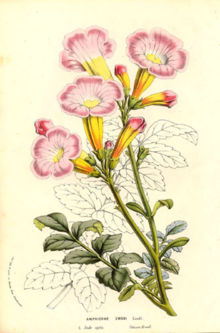Incarvillea
| subsp. var. | ||||||||||||||||||||||||||||||||||||||||||||||||||||||||
|---|---|---|---|---|---|---|---|---|---|---|---|---|---|---|---|---|---|---|---|---|---|---|---|---|---|---|---|---|---|---|---|---|---|---|---|---|---|---|---|---|---|---|---|---|---|---|---|---|---|---|---|---|---|---|---|---|

|
|
| ||||||||||||||||||||||||||||||||||||||||||||||||||||||
| ||||||||||||||||||||||||||||||||||||||||||||||||||||||||
| Standard Cyclopedia of Horticulture |
|---|
|
Incarvillea (after Incarville, the French Jesuit missionary to China, correspondent of Jussieu in 1743). Bignoniaceae. Showy herbs, annual, biennial, or perennial, planted in the open. Closely allied to amphicorne, and the fls. of both have the same general appearance, but in Incarvillea the calyx-lobes are awl-shaped, while in amnphicorne the calyx is truncate or shortly dentate; also the seeds of Incarvillea have an entire hyaline wing, while in amphicorne the seeds have a wing that is cut into long thin strips or hairs. The two genera form a small but remarkable group, characterized by their caps, opening by the ventral suture only. Calyx campanulate, 5-lobed; corolla-tube elongated, enlarging: limb somewhat 2-lipped, the lobes 5, spreading and broad; stamens 4, included, didynamous; disk annular or ring- like; ovary 2-loculed: fr. a narrow more or less curved caps, with many seeds: plant erect, branching or simple: lvs. alternate, 2-3-pinnate or simple, with narrow segms.: fls. large, in terminal clusters, red to yellow. — Species about a dozen, Turkestan, Tibet, China. The general experience seems to be that these plants need rather more winter protection than most hardy herbaceous perennials. A light, sandy loam, well enriched and deeply worked, suits them well, and they like a sheltered position in a rather warm, sunny place. Prop, by division or seed. Indian bean: Catalpa. I. Cherry: Rhamnua caroliniana. I. Corn: Zea Mays. I. Cress: Tropaeolum. I. Cucumber-root: Medeola virginica. I. Currant: Symphoricarpos vulgaris. I. Fig: Opuntia vulgaris. I. Hemp: Apocynum cannabinum. I. Mallow: Abutilon. I. Physic: (Gillenia. I. Pipe: Monotropa. I. Rice: Zizania. aquatica. I. Shot: Canna. I. Tobacco: Lobelia inflata. I. Turnip: Arisaema triphylla. I. Wheat: Fagopyrum lataricum.
|
| Incarvillea {{{status}}} Fossil range: {{{fossil_range}}}
| ||||||||||||||||||||||||||||||||||||||||||||||||||||||||||||||||||
|---|---|---|---|---|---|---|---|---|---|---|---|---|---|---|---|---|---|---|---|---|---|---|---|---|---|---|---|---|---|---|---|---|---|---|---|---|---|---|---|---|---|---|---|---|---|---|---|---|---|---|---|---|---|---|---|---|---|---|---|---|---|---|---|---|---|---|
 Incarvillea emodi | ||||||||||||||||||||||||||||||||||||||||||||||||||||||||||||||||||
| Plant Info | ||||||||||||||||||||||||||||||||||||||||||||||||||||||||||||||||||
| ||||||||||||||||||||||||||||||||||||||||||||||||||||||||||||||||||
| Scientific classification | ||||||||||||||||||||||||||||||||||||||||||||||||||||||||||||||||||
| ||||||||||||||||||||||||||||||||||||||||||||||||||||||||||||||||||
| [[{{{diversity_link}}}|Diversity]] | ||||||||||||||||||||||||||||||||||||||||||||||||||||||||||||||||||
| {{{diversity}}} | ||||||||||||||||||||||||||||||||||||||||||||||||||||||||||||||||||
| Binomial name | ||||||||||||||||||||||||||||||||||||||||||||||||||||||||||||||||||
| {{{binomial}}} | ||||||||||||||||||||||||||||||||||||||||||||||||||||||||||||||||||
| Trinomial name | ||||||||||||||||||||||||||||||||||||||||||||||||||||||||||||||||||
| {{{trinomial}}} | ||||||||||||||||||||||||||||||||||||||||||||||||||||||||||||||||||
| Type Species | ||||||||||||||||||||||||||||||||||||||||||||||||||||||||||||||||||
| {{{type_species}}} | ||||||||||||||||||||||||||||||||||||||||||||||||||||||||||||||||||
| Genera | ||||||||||||||||||||||||||||||||||||||||||||||||||||||||||||||||||
| See text. | ||||||||||||||||||||||||||||||||||||||||||||||||||||||||||||||||||
| [[Image:{{{range_map}}}|{{{range_map_width}}}|]] | ||||||||||||||||||||||||||||||||||||||||||||||||||||||||||||||||||
| Synonyms | ||||||||||||||||||||||||||||||||||||||||||||||||||||||||||||||||||
| {{{synonyms}}} |
Incarvillea is a genus of 16 species of flowering plants in the family Bignoniaceae, native to central and eastern Asia, with most of the species growing at high altitudes in the Himalaya and Tibet. The most familiar species is Incarvillea delavayi, a garden plant commonly known as "hardy gloxinia" or "Chinese trumpet flower". Unlike most other members of Bignoniaceae, which are usually trees or lianas, species of Incarvillea are stemless perennial herbs with fleshy tuberous roots.
Incarvillea is named after the french jesuit, Pierre Nicholas Le Chéron d'Incarville.
- Selected species
- Incarvillea altissima
- Incarvillea arguta
- Incarvillea beresowskii
- Incarvillea compacta
- Incarvillea delavayi
- Incarvillea dissectifoliola
- Incarvillea emodi
- Incarvillea forrestii
- Incarvillea lutea
- Incarvillea mairei
- Incarvillea olgae
- Incarvillea potaninii
- Incarvillea sinensis (syn. I. variabilis)
- Incarvillea younghusbandii
- Incarvillea zhongdianensis